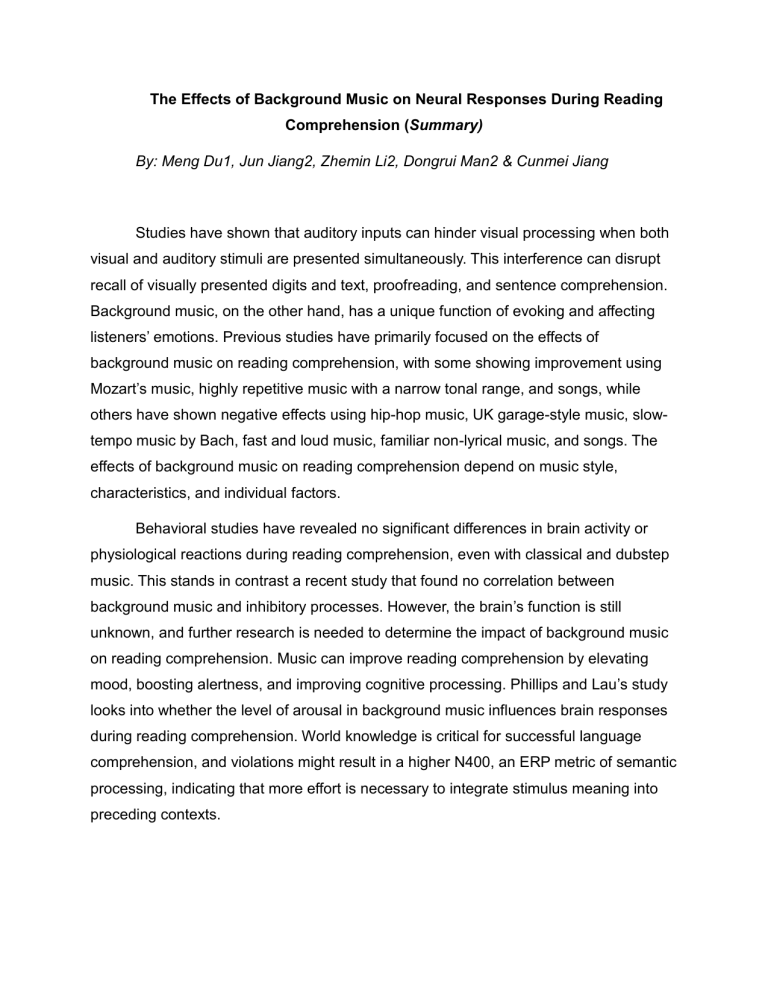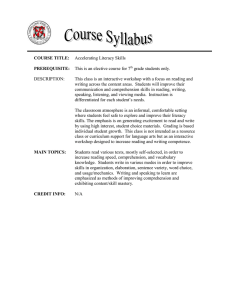
The Effects of Background Music on Neural Responses During Reading Comprehension (Summary) By: Meng Du1, Jun Jiang2, Zhemin Li2, Dongrui Man2 & Cunmei Jiang Studies have shown that auditory inputs can hinder visual processing when both visual and auditory stimuli are presented simultaneously. This interference can disrupt recall of visually presented digits and text, proofreading, and sentence comprehension. Background music, on the other hand, has a unique function of evoking and affecting listeners’ emotions. Previous studies have primarily focused on the effects of background music on reading comprehension, with some showing improvement using Mozart’s music, highly repetitive music with a narrow tonal range, and songs, while others have shown negative effects using hip-hop music, UK garage-style music, slowtempo music by Bach, fast and loud music, familiar non-lyrical music, and songs. The effects of background music on reading comprehension depend on music style, characteristics, and individual factors. Behavioral studies have revealed no significant differences in brain activity or physiological reactions during reading comprehension, even with classical and dubstep music. This stands in contrast a recent study that found no correlation between background music and inhibitory processes. However, the brain’s function is still unknown, and further research is needed to determine the impact of background music on reading comprehension. Music can improve reading comprehension by elevating mood, boosting alertness, and improving cognitive processing. Phillips and Lau’s study looks into whether the level of arousal in background music influences brain responses during reading comprehension. World knowledge is critical for successful language comprehension, and violations might result in a higher N400, an ERP metric of semantic processing, indicating that more effort is necessary to integrate stimulus meaning into preceding contexts. Lau’s research emphasizes the role of music listening in enhancing comprehension of texts and cognitive skills. The study looks into whether the level of arousal in background music influences brain responses during reading comprehension. It also investigates the significance of global knowledge in effective understanding. Previous research has found that breaches of world knowledge result in a higher N400, indicating that more effort is necessary to incorporate stimulus meaning into context. The investigation focused on the impact of background music on participants’ psychological excitement levels. A nonparametric ANOVA-type statistic (ATS) was employed to examine the whole-plot factor and sentence type. The results revealed no significant impacts on the major effects of group and sentence style, or their interaction. The study also looked at the impact of background music on participants’ arousal levels, and found no significant effects on group, time, or interaction. These results imply that background music had no effect on participants’ emotional arousal levels. The electrophysiological results showed that world knowledge violations elicited a larger N400 than correct sentences in the 200-450 ms time windows. However, the magnitude of the N400 effect seemed to differ between the groups with and without background music. A three-way mixed ANOVA was conducted for the midline electrodes, taking group as the between-subjects factor and sentence type and anteriority as the within-subjects factors. A significant main effect was found for sentence type, with a larger N400 elicited by world knowledge violations than correct sentences in the silence, low-arousal, and high-arousal music groups. A two-way mixed ANOVA was conducted to further examine the differences in the magnitude of the N400 effect among the three groups. The study Investigated the effects of background music on neural responses during reading comprehension using ERPs. Results showed that a larger N400 effect was elicited in response to world knowledge violations than correct controls, either with or without background music. The N400 effect for silence was smaller than for high and low-arousal music backgrounds, with no significant difference between the two. The study suggests that background music influences neural responses during reading comprehension, and musical arousal level does not alter its effects. The study reveals that background music, which may demand attention resources, reduces the N400 effect, causing difficulties in sentence integration. This is consistent with Burkhard’s findings, which showed no difference in inhibitory function between relaxing and exciting background music conditions. The study also found that neither high- nor low-arousal background music induced emotional arousal, possibly due to the characteristics of the music. The competition for attention resources during cognitive processing may also account for the failure to induce emotional arousal. The present study explores the neural processing of world knowledge integration in sentence comprehension using reading stimuli written in Chinese, an ideographic language. The background music was Western tonal music composed in the Baroque and Classical periods, allowing both Western and Chinese listeners to process and exhibit similar neural responses to these tonal structures, potentially applicable to other alphabetic language populations. Background music influences neural responses during reading comprehension, regardless of arousal level. It disrupts cognitive processing of visually based tasks, causing a significant effect on non-music cognitive processing. However, when presented simultaneously with the reading task, neither high nor lowarousal music increased arousal levels, increasing semantic integration difficulties during reading comprehension. The study used Adobe Audition software to analyze background music stimuli, including fast-tempo and slow-tempo music in major mode. Major mode music tends to induce a positive mood and increase arousal levels, while slow-tempo music tends to induce a negative mood and lower arousal levels. A pretest was conducted to assess the emotional valence and arousal levels of the selected music excerpts. Sixteen participants, who preferred listening to music during reading, rated each music excerpt on two 6-point scales. The results showed that high-arousal and low-arousal music significantly differed in perceived arousal levels and perceived valence. Participants in a Chinese experiment were asked to rate the reasonableness of correct sentences based on their knowledge of the subject. The study involved 90 original Chinese sentences, each consisting of three to seven words. The participants were asked to rate the reasonableness of the sentences on a 5-point scale. The results showed that correct sentences and sentences with world knowledge violations differed significantly in reasonableness. Procedures. Participants in an ERP experiment were tested on their response timing and stimulus presentation. The experiment involved four trials, each with a red flashing point and a blank screen. Participants were instructed to press either the F or J key to indicate the correctness of a sentence. The response timing was counterbalanced across participants to control for handedness effects and avoid lateralization of topographies. Background music was played throughout, and EEG recordings were conducted. Arousal levels were measured using a 6-point scale, and participants were asked to report their familiarity with the music and their liking. All participants reported being unfamiliar with the music and liking it. Visual inspection and previous studies of language comprehension were used for statistical analysis, considering a time window of 200-450 ms before the onset of the critical word. Nine regions of interest (ROIs) were computed, and mixed ANOVA was performed with IBM SPSS 25 for midline and lateral regions. For midline regions, group (high-arousal music, low-arousal music, and silence) was considered as the betweensubjects factor, while sentence type (correct vs. world knowledge violation) and anteriority (anterior, central, and posterior) were considered as the within-subjects factors. Difference waves were also considered to compare the magnitude of the N400 effect.



